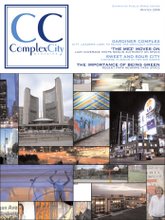The importance of being green

BY LIZ DEWDNEY
The green space and parkland in Regent Park is all but gone. According to former resident Tyrone MacLean-Wilson, the old swing sets he used as a child there have long since been torn down.
“Playgrounds are an important thing to have,” he says. “The population of Regent Park is mostly children.”
Though MacLean-Wilson moved out of the area about two years ago, he still lives nearby and is very active within the community. He’s worked with a local community group, Regent Park Focus for 10 years.
Regent Park is bordered by Shuter, Gerrard, River and Parliament Streets. The original, low income housing, development began in the late 1940s and was completed in the late 1950s. While it was supposed to be a bastion in modern urban design, it is widely viewed as a failure.
Because of this, Toronto Community Housing (TCHC), an arms length city organization that provides housing for low-income households, has started a revitalization of the area.
According to Eric Pedersen, urban design project manager for the south district of Toronto, the original Regent Park green space did not seem public.
“Though there was open space all around,” he said, “there was no defined public space.”
The open space to which Pedersen refers is encompassed by residential apartment buildings, making it hard for the general public to enter. With the revitalization plan, the buildings surrounding one of the larger green spaces will be torn down. This will triple the size of the space, located just south of Oak Street between Sackville and Sumach Streets.
Pedersen says that the redesigned park should serve the Regent Park community in a way similar to Trinity-Bellwoods Park in Toronto’s west end. While Trinity-Bellwoods Park has many recreational facilities, such as an indoor pool, outdoor tennis courts in the summer and skating rink in the winter, it’s the accessibility that Pedersen would like to see mimicked in the Regent Park revitalization.
“We’re hopeful that the park space will be like Trinity-Bellwoods,” he said, “where people can get multi-use facilities, but still have open access to enough undefined space to use as they like.”
Pedersen says the openness helps Trinity-Bellwoods Park work for residents. Park users can enter from all four directions, from Dundas Street on the north border, from Queen Street on the south and from side streets on the east and west.
According to Laurie Stephens, the director of stakeholder relations for the TCHC, the amenities that go into the redeveloped Regent Park space will be determined by the residents.
“The TCHC could sit around and decide what to put into that space,” she says, “but if we end up putting in a basketball court, but it turns out that what the residents really want is a BMX track, then that space will not get used.”
Stephens points out that the area in question is not slated for redevelopment until 2014. Though, depending on the progress of the project comes, it could be started much sooner.
For now a small, playground and basketball court, until now in a state of disrepair, has been refurbished. According to Stephens it is now very widely used.
MacLean-Wilson agrees that the new space is great and would like to see even more playgrounds put in.
“I still bring my little sisters to play in the area,” he said, “it would be nice for them to have somewhere to play.”





No comments:
Post a Comment